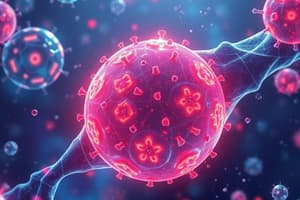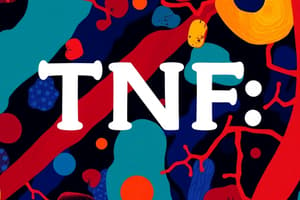Podcast
Questions and Answers
What is the main biological response of TNF-α?
What is the main biological response of TNF-α?
- Induction of apoptosis in healthy cells
- Inhibition of immune response
- Activation of immunity, inflammation, and cytotoxicity against tumor cells (correct)
- Regulation of insulin release
What is Beromun?
What is Beromun?
- An anti-TNF monoclonal antibody
- A synthetic hormone used to regulate blood glucose levels
- A therapeutic agent based on TNF-α used to treat soft-tissue sarcoma (correct)
- A hormone produced by pancreatic beta cells
What is Enbrel?
What is Enbrel?
- An enzyme that breaks down insulin
- An approved product used to treat rheumatoid arthritis made of the extracellular domain of the TNF receptor fused to the Fc region of human IgG (correct)
- A hormone that stimulates growth in children
- A hormone produced by the pituitary gland that stimulates gonads
What is the function of insulin?
What is the function of insulin?
What is the most potent stimulus of pancreatic insulin release?
What is the most potent stimulus of pancreatic insulin release?
What are anti-TNF monoclonal antibodies used for?
What are anti-TNF monoclonal antibodies used for?
What are therapeutic hormones?
What are therapeutic hormones?
What is the function of glucagon?
What is the function of glucagon?
What is the role of insulin in glucose metabolism?
What is the role of insulin in glucose metabolism?
What results from autoimmune destruction of pancreatic β-cells that produce insulin?
What results from autoimmune destruction of pancreatic β-cells that produce insulin?
What is the structure of insulin?
What is the structure of insulin?
What is the marker for insulin secretion?
What is the marker for insulin secretion?
How is recombinant human insulin produced?
How is recombinant human insulin produced?
What is the alternative approach to producing human insulin using E. coli?
What is the alternative approach to producing human insulin using E. coli?
What is the focus of improving insulin analogues?
What is the focus of improving insulin analogues?
What is the function of insulin in glucose metabolism?
What is the function of insulin in glucose metabolism?
What causes Type-1 diabetes?
What causes Type-1 diabetes?
What is the structure of insulin?
What is the structure of insulin?
What is the function of C-peptide in insulin production?
What is the function of C-peptide in insulin production?
How is recombinant human insulin produced?
How is recombinant human insulin produced?
What is the purpose of amino acid substitutions in insulin analogues?
What is the purpose of amino acid substitutions in insulin analogues?
What is the annual insulin requirement for people with diabetes worldwide?
What is the annual insulin requirement for people with diabetes worldwide?
What is the major physiological function of glucagon?
What is the major physiological function of glucagon?
Which insulin analogue has a C-terminal asparagine residue replaced by a glycine residue and an elongated B-chain with two arginine residues?
Which insulin analogue has a C-terminal asparagine residue replaced by a glycine residue and an elongated B-chain with two arginine residues?
Which of the following is NOT a fast-acting modified insulin that can be injected at mealtimes rather than one hour before?
Which of the following is NOT a fast-acting modified insulin that can be injected at mealtimes rather than one hour before?
What is the major difference between open-loop and closed-loop insulin infusion systems?
What is the major difference between open-loop and closed-loop insulin infusion systems?
Which inhalable insulin product was produced by recombinant E. coli and absorbed as quickly as subcutaneously administered rapid-acting insulin analogues?
Which inhalable insulin product was produced by recombinant E. coli and absorbed as quickly as subcutaneously administered rapid-acting insulin analogues?
Which long-acting insulin analogue exhibits a plasma half-life of up to 35 hours?
Which long-acting insulin analogue exhibits a plasma half-life of up to 35 hours?
Which rapid-acting inhalable insulin is produced by Mannkind Corporation and licenced to Sanofi, with a delivery system that is small, sleek, and dosed in units rather than milligrams?
Which rapid-acting inhalable insulin is produced by Mannkind Corporation and licenced to Sanofi, with a delivery system that is small, sleek, and dosed in units rather than milligrams?
Flashcards are hidden until you start studying
Study Notes
Therapeutic Uses of TNF-α and Hormones
- TNF family includes TNF-α and TNF-β, which bind to the same receptors but have limited similarity at the amino acid level.
- TNF-α is mainly synthesized by activated macrophages and is proteolytically processed to its active form as a homotrimer.
- TNF biosynthesis is regulated at both transcriptional and post-translational levels, and its major biological responses include activation of immunity, inflammation, and cytotoxicity against tumor cells.
- TNF-α was initially studied for its anti-tumor activity, which was enhanced by IFN-γ and induced by bacterially derived LPS.
- TNF-α can mediate cell death via apoptosis or necrosis, but systemic administration of TNF-α has severe side effects.
- Beromun is a therapeutic agent based on TNF-α that is used in combination with melphalan to treat soft-tissue sarcoma and prevent limb amputation.
- Anti-TNF monoclonal antibodies or soluble forms of the TNF receptor are used to neutralize TNF-α's biological effects and treat conditions associated with elevated TNF levels.
- Enbrel is an approved product that is used to treat rheumatoid arthritis and is made of the extracellular domain of the TNF receptor fused to the Fc region of human IgG.
- Therapeutic hormones are substances synthesized and released from a specific gland in the body that interact with a receptor on a distant sensitive cell and bring about a change.
- Insulin is a polypeptide hormone produced by pancreatic beta cells that regulates blood glucose levels and targets skeletal muscle fibers, hepatocytes, and adipocytes.
- The most potent stimulus of pancreatic insulin release is an increase in blood glucose levels after meals.
- Other therapeutic hormones include glucagon, growth hormone, and gonadotrophins.
Insulin: its role, structure, and production
- Insulin regulates glucose metabolism by stimulating glucose uptake, inhibiting glycogenolysis, and promoting anabolic pathways.
- Insulin-dependent diabetes mellitus (Type-1 diabetes) results from autoimmune destruction of pancreatic β-cells that produce insulin.
- Insulin is a 51 amino acid protein that is synthesized as a precursor molecule called preproinsulin.
- Proinsulin is processed to mature insulin and C-peptide, which can be used as a marker for insulin secretion.
- Commercial insulin was traditionally extracted from pig or cattle pancreas, but has immunogenicity and availability issues.
- Recombinant DNA technology enabled the production of human insulin, which was approved for therapeutic use in 1982.
- Recombinant human insulin is produced by inserting nucleotide sequences coding for A- and B-chains into E. coli cells, which are then purified and recombined in vitro.
- An alternative approach involves inserting a nucleotide sequence coding for human proinsulin into E. coli, which is then purified and proteolytically modified to produce human insulin.
- Recombinant DNA technology also enables the production of insulin analogues with modified amino acid sequences that alter their biological activity.
- Insulin analogues with aa substitutions at contact points between insulin molecules promote charge repulsion or steric hindrance to prevent dimerization or polymerization.
- Improving insulin analogues has centered on developing faster-acting insulins that do not form higher polymers at therapeutic doses.
- Approximately 170 million people worldwide suffer from diabetes, and the annual insulin requirement has surpassed 5,000 Kg and continues to grow.
Insulin and Glucagon: Types, Modifications, and Alternative Delivery Methods
- Insulin lispro and insulin aspart are fast-acting modified insulins that can be injected at mealtimes rather than one hour before.
- Insulin aspart has an aspartate residue at B28, decreasing self-association and ensuring immediate entry into the bloodstream upon administration.
- Insulin glargine and Levemir are long-acting insulin analogues that exhibit plasma half-lives of up to 35 hours and 25 hours, respectively.
- Insulin glargine has a C-terminal asparagine residue replaced by a glycine residue and an elongated B-chain with two arginine residues, increasing the molecule's pI to reduce its solubility.
- Levemir is devoid of threonine B30 and contains a 14-carbon fatty acid residue covalently attached to the side chain of lysine B29, ensuring constant and prolonged release of free insulin.
- Alternative insulin delivery methods include inhalable insulin and infusion systems.
- Exubera was the first inhalable insulin product, produced by recombinant E. coli and absorbed as quickly as subcutaneously administered rapid-acting insulin analogues.
- Afrezza is a rapid-acting inhalable insulin produced by Mannkind Corporation and licenced to Sanofi, with a delivery system that is small, sleek, and dosed in units rather than milligrams.
- Infusion systems can deliver insulin constitutively and mimic normal changes in blood insulin levels.
- Open-loop systems consist of an infusion pump that automatically infuses soluble insulin subcutaneously, while closed-loop systems have an integral glucose sensor and computer that adjusts the flow rate accordingly.
- Glucagon is a single-chain polypeptide of 29 amino acids synthesized by the A-cells of the islets of Langerhans and increases blood glucose levels.
- The major physiological function of glucagon is to prevent hypoglycemia.
Studying That Suits You
Use AI to generate personalized quizzes and flashcards to suit your learning preferences.




